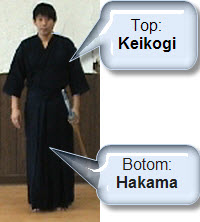Kendo
Kendo (剣道, Kendō, lit. 'sword way', 'sword path' or 'way of the sword')[1] is a modern Japanese martial art, descended from kenjutsu (one of old Japanese martial arts, swordsmanship), that uses bamboo swords (shinai) as well as protective armor (bōgu). Today, it is widely practiced within Japan and has spread to many other nations across the world.
Kendo is an activity that combines martial arts practices and values with strenuous, sport-like physical activity.
Practitioners
Practitioners of kendo are called kendōka (剣道家), meaning "someone who practices kendo", or occasionally kenshi (剣士), meaning "swordsman". Additionally, the old term of kendoists is sometimes used. The Kodansha Meibo, a register of dan graded members of the AJKF, lists (as of September 2007) 1.48 million registered dan graded kendōka in Japan. According to a survey conducted by AJKF, the number of active kendo practitioners in Japan is 477,000, including 290,000 dan holders. From these figures, AJKF estimates that the number of kendōka in Japan is 1.66 million, with over 6 million practitioners worldwide, with registered dan holders and active kendo practitioners without dan grade.
Concept of Kendo
- Kendo is a way to discipline the human character through the application of the principles of the katana.
Purpose
- To mold the mind and body.
- To cultivate a vigorous spirit,
- And through correct and rigid training,
- To strive for improvement in the art of Kendo.
- To hold in esteem human courtesy and honor.
- To associate with others with sincerity.
- And to forever pursue the cultivation of oneself.
- Thus will one be able:
- To love ones country and society;
- To contribute to the development of culture;
- And to promote peace and prosperity among all peoples.
Equipment
The shinai is meant to represent a Japanese sword (katana) and is made up of four bamboo slats which are held together by leather fittings. A modern variation of a shinai with carbon fiber reinforced resin slats is also used.
Kendōka also use hard wooden swords (木刀, bokutō) to practice kata.
Kendo employs strikes involving both one edge and the tip of the shinai or bokutō.
Protective armor is worn to protect specified target areas on the head, arms, and body. The head is protected by a stylized helmet, called men (面), with a metal grille (面金, men-gane) to protect the face, a series of hard leather and fabric flaps (突垂れ, tsuki-dare) to protect the throat, and padded fabric flaps (面垂れ, men-dare) to protect the side of the neck and shoulders. The forearms, wrists, and hands are protected by long, thickly padded fabric gloves called kote (小手). The torso is protected by a breastplate (胴, dō), while the waist and groin area are protected by the tare (垂れ), consisting of three thick vertical fabric flaps or faulds.
Clothing
The clothing worn under the bōgu comprise a jacket (kendogi or keikogi) and hakama, a garment separated in the middle to form two wide trouser legs.
A cotton towel (手拭い, tenugui) is wrapped around the head, under the men, to absorb perspiration and provide a base for the men to fit comfortably.
Shinai
Shinai (竹刀?) is a weapon used for practice and competition in Kendo representing a Japanese sword. Shinai are also used in other martial arts, but may be styled differently from Kendo shinai, and represented with different characters.
The word "shinai" is derived from the verb shinau (撓""), meaning "to bend, to flex", and was originally short for shinai-take (flexible bamboo). Shinai is written with the kanji 竹刀, meaning "bamboo sword", and is an irregular kanji reading.
In kendo, it is most common to use a single shinai, sometimes called itto style. Some kendoka choose to use two shinai. This kendo style is usually called nitō (二刀?), a style that has its roots in the two-sword schools of swordsmanship such as Hy"h" Niten Ichi-ryū. A ni-to combatant uses a long shinai called the daitō (大刀?), which is usually held in the left hand, and a shorter shinai, called the sh"t" ("刀?), which is usually held in the right hand. The daitō may be slightly shorter and lighter than a shinai used in the itto style of kendo. Specifications for shinai used in kendo competitions must follow the International Kendo Federation (FIK) rules.
History
The origin of the shinai can be found in the Edo period. The shinai was developed when a group of swordsmen, in an effort to reduce the number of practitioners being seriously injured during practice, undertook to create a practice weapon that was less dangerous than bokuto (木刀?), the hard wooden swords they were previously using. This is also the motivation behind the development of bogu (防具?), the armour that protects the kendoka.
See also [ Bamboo ]
Chat rooms • What links here • Copyright info • Contact information • Category:Root
